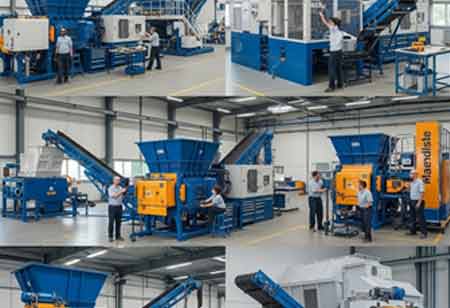Thank you for Subscribing to Environmental Business Review Weekly Brief
Smart Waste Handling Solutions: Canada's Push for Environmental Compliance and Efficiency
Canada's waste-handling solutions prioritize innovative machinery for efficiency, versatility, safety, and compliance with evolving environmental regulations.

By
Environmental Business Review | Monday, September 29, 2025
Stay ahead of the industry with exclusive feature stories on the top companies, expert insights and the latest news delivered straight to your inbox. Subscribe today.
Solid waste is an unavoidable by-product of modern industry, but methods for treating, managing, and processing this waste have significantly evolved over the past few decades. From landfills to recycling centers, the systems designed to handle waste rely on a complex network of equipment that efficiently sorts, transports, compacts, and repurposes materials.
At the core of this network are manufacturers of waste handling equipment—specialists who design machinery to help create cleaner and more sustainable operations. The tightening of environmental regulations and the increasing pressure on industries to reduce their ecological footprint have led to a record demand for innovative, high-performance waste handling solutions.
Waste-handling equipment manufacturers in Canada have grown far beyond their original role of simply being machine suppliers. Manufacturers nowadays have become acting partners in helping their business clients with material flow optimization, operational cost reduction, and sustainability target achievement.
With advanced design, engineering prowess, and customization methods, these manufacturers are equipped to meet numerous needs across numerous sectors, from construction to manufacturing, retail, and hospitality. Present-day waste handling equipment is a smart balancing act between mechanics, automation, and environmental foresight, all of which stand to ensure efficiency, durability, and compliance.
Design for Versatility and Performance
Versatility is one of the primary trends highlighted in manufacturing waste-handling equipment. A facility generally generates mixtures of waste: organic, recyclable, hazardous, bulky, and all such different wastes need machines that are adjustable and strong. Canadian manufacturers cater to this need by producing more equipment capable of processing multiple streams of waste that can apply to a wide variety of materials, but give no compromise to speed and efficiency.
Compactors, balers, shredders, and conveyors have all been designed with these changes in mind, with options for customizable settings and modular components that allow operators to configure machinery for different types of waste.
With versatility comes the push for performance. The equipment must process the highest volumes with the least downtime and low maintenance requirements. Advancements stand behind innovations in hydraulic systems, motor efficiency, and material handling automation, making machines faster, stronger, and more energy efficient.
The quicker the machines work, the lower the long-term costs they translate to the facilities. Manufacturers also adopt extensive testing and quality assurance protocols to ensure reliability, frequently over the set industry standards, delivering machinery that can perform in some of the most challenging situations.
Safety is yet another aspect of performance. With machines getting more powerful and complicated, operator well-being remains a top priority. Modern machines come with advanced control panels, emergency-stop functions, automatic shut-off, and lucid operational interfaces, reducing the probability of accidents. Ergonomically designed features will improve operator interaction by reducing strain and fatigue, increasing efficacy in high-usage environments.
Integrating Smart Technology into Equipment Systems
In the ongoing digital transformation of industries, manufacturers of waste-handling equipment are embedding innovative technologies into their machines to enhance functionality and oversight. The adoption of sensors, real-time data analytics, and remote monitoring is redefining how facilities interact with their equipment.
The innovative systems can monitor usage patterns, predict maintenance needs, and optimize performance parameters without human supervision. Access to this data via integrated platforms allows facility managers to make informed decisions that improve operational efficiency and decrease waste-related costs.
With remote diagnostics, modern equipment asks basic questions while a manufacturer solves a problem. When an issue arises, the manufacturer evaluates it from a remote site to troubleshoot it, and more often than not, the problem can be fixed without a technician coming on-site. This lessens equipment downtime while ensuring operations continue uninterrupted. Also, software-driven control systems permit programmable cycles, auto-configuration based on load type, and compliance logging, all smart moves that help make waste handling more agile.
These technologies help industries comply with an increasingly complex set of environmental regulations. Automated documentation of waste processing volumes, energy consumption, and emissions data plays a key role in compliance reporting and environmental auditing. These enhancements are not applications for increasing efficiency; they represent strategic resources put in place to accomplish long-term sustainability goals.
Supporting Sustainability through Engineering Innovations
Sustainability is becoming the heart of today's waste handling, and Canadian manufacturers have responded to those challenges by designing equipment that reduces environmental impact at every stage. Every design decision reduces the overall environmental impact, from energy-efficient motors and hydraulic systems to recyclable or responsibly sourced materials. By maximizing compaction ratios and enabling material recovery, the equipment can lessen the burden on landfills and ultimately promote the circular economy.
Significant innovations are also changing machine processes, aiding segregation and sorting. Advanced balers compress recyclable material into bales of uniform size, making handling easy, thereby improving the value and marketability of the recovered material. Shredders and sorters endowed with optical sensors and AI-based sorting algorithms can accurately identify and isolate various waste streams. These innovations will increase the recycling rate and minimize contamination, among the most significant problems in the recycling field.
More in News





